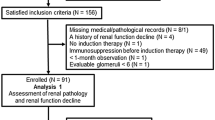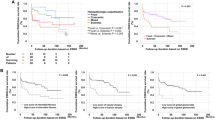Abstract
The demographic features, and clinical and histological characteristics of lupus nephritis (LN) patients with hypertension in the Chinese population remain unclear. Hence, the clinical characteristics of LN with and without hypertension were retrospectively analyzed. A total of 764 LN patients (53.1%) were hypertensive. These hypertensive patients had higher levels of serum creatinine and blood urea nitrogen, and lower estimated glomerular filtration rates, when compared to their normotensive counterparts (P < 0.05). Furthermore, these hypertensive patients had higher median acuity index and chronicity index scores, when compared to normotensives (P < 0.001). In terms of histology, hypertensive patients were more likely to develop glomerular sclerosis, thickened glomerular capillary loops, or crescent formations, and had more severe endothelial cell proliferation, when compared to normotensive patients (P < 0.001). Hypertensive patients also had a higher percentage for more severe tubular atrophy, interstitial inflammatory cell infiltration and interstitial fibrosis (P < 0.001). Compared with normotensive patients, hypertensive patients exhibited a significant decline in survival time and rate for all end points (P < 0.01). The presence of hypertension was an independent predictor of mortality (P = 0.009), ESRD (P = 0.026), and doubling of serum creatinine (P = 0.017). In conclusion, hypertension is associated with poor clinical and renal outcome in LN patients. The monitoring and control of hypertension should be considered an important clinical goal in the treatment of LN patients.
This is a preview of subscription content, access via your institution
Access options
Subscribe to this journal
Receive 12 digital issues and online access to articles
$119.00 per year
only $9.92 per issue
Buy this article
- Purchase on Springer Link
- Instant access to full article PDF
Prices may be subject to local taxes which are calculated during checkout



Similar content being viewed by others
References
Cojocaru M, Cojocaru IM, Silosi I, Vrabie CD. Manifestations of systemic lupus erythematosus. Maedica. 2011;6:330–6.
Hahn BH, McMahon MA, Wilkinson A, Wallace WD, Daikh DI, Fitzgerald JD, et al. American College of Rheumatology guidelines for screening, treatment, and management of lupus nephritis. Arthritis Care Res. 2012;64:797–808.
Schwartzman-Morris J, Putterman C. Gender differences in the pathogenesis and outcome of lupus and of lupus nephritis. Clin Dev Immunol. 2012;2012:604892.
Lech M, Anders HJ. The pathogenesis of lupus nephritis. J Am Soc Nephrol. 2013;24:1357–66.
Avihingsanon Y, Hirankarn N. Major lupus organ involvement: severe lupus nephritis. Lupus. 2010;19:1391–8.
de Zubiria Salgado A, Herrera-Diaz C. Lupus nephritis: an overview of recent findings. Autoimmune Dis. 2012;2012:849684.
Mok CC, Wong RW, Lau CS. Lupus nephritis in Southern Chinese patients: clinicopathologic findings and long-term outcome. Am J Kidney Dis. 1999;34:315–23.
Faurschou M, Starklint H, Halberg P, Jacobsen S. Prognostic factors in lupus nephritis: diagnostic and therapeutic delay increases the risk of terminal renal failure. J Rheumatol. 2006;33:1563–9.
Bradshaw SE. Lupus nephritis: Sustained proteinuria and dyslipidemia are risk factors for progressive CKD in patients with lupus nephritis. Nat Rev Nephrol. 2011;7:184.
Vozmediano C, Rivera F, López-Gómez JM, Hernández D. Risk factors for renal failure in patients with lupus nephritis: data from the spanish registry of glomerulonephritis. Nephron Extra. 2012;2:269–77.
Wu JY, Yeh KW, Huang JL. Early predictors of outcomes in pediatric lupus nephritis: focus on proliferative lesions. Semin Arthritis Rheum. 2014;43:513–20.
Korbet SM, Schwartz MM, Evans J, Lewis EJ. Severe lupus nephritis: racial differences in presentation and outcome. J Am Soc Nephrol. 2007;18:244–54.
Kammoun K, Jarraya F, Bouhamed L, Kharrat M, Makni S, Hmida MB, et al. Poor prognostic factors of lupus nephritis. Saudi J Kidney Dis Transpl. 2011;22:727–32.
Drakoulogkona O, Barbulescu AL, Rica I, Musetescu AE, Ciurea PL. The outcome of patients with lupus nephritis and the impact of cardiovascular risk factors. Curr Health Sci J. 2011;37:70–4.
Petrin J, Rozman B, Dolenc P, Logar D, Bozic B, Vizjak A, et al. The dissociation of arterial hypertension and lupus glomerulonephritis in systemic lupus erythematosus. Blood Press. 1993;2:108–12.
Hochberg MC. Updating the American College of Rheumatology revised criteria for the classification of systemic lupus erythematosus. Arthritis Rheum. 1997;40:1725.
Dimitrijević J, Dukanović L, Kovacević Z, Bogdanović R, Maksić D, Hrvacević R, et al. Lupus nephritis: histopathologic features, classification and histologic scoring in renal biopsy. Vojnosanit Pregl. 2002;59:21–31.
KDIGO. Clinical practice guideline for the evaluation and management of chronic kidney disease. Kidney Int Suppl. 2013;3:1–150. 2012
Lam GK, Petri M. Assessment of systemic lupus erythematosus. Clin Exp Rheumatol. 2005;23 Suppl 39:S120–32.
Ma YC, Zuo L, Chen JH, Luo Q, Yu XQ, Li Y, et al. Modified glomerular filtration rate estimating equation for Chinese patients with chronic kidney disease. J Am Soc Nephrol. 2006;17:2937–44.
Naiker IP, Chrystal V, Randeree IG, Seedat YK. The significance of arterial hypertension at the onset of clinical lupus nephritis. Postgrad Med J. 1997;73:230–3.
Shaharir SS, Mustafar R, Mohd R, Mohd Said MS, Gafor HA. Persistent hypertension in lupus nephritis and the associated risk factors. Clin Rheumatol. 2015;34:93–7.
Swaak AJ, van den Brink HG, Smeenk RJ, Manger K, Kalden JR, Tosi S, et al. Systemic lupus erythematosus: clinical features in patients with a disease duration of over 10 years, first evaluation. Rheumatology. 1999;38:953–8.
Christine H, Anthony C, Daniel B, Riteesha G, Tammy OU, Marcus RC. Tubulointerstitial inflammation and scarring predict outcome in lupus nephritis. Arthritis Care Res. 2011;63:865–74.
Saxena R, Mahajan T, Mohan C. Lupus nephritis: current update. Arthritis Res Ther. 2011;13:240.
Sui M, Ye X, Ma J, Yu C, Zhao S, Liu X, et al. Epidemiology and risk factors for chronic kidney disease in Chinese patients with biopsy-proven lupus nephritis. Intern Med J. 2015;45:1167–72.
Singh S, Zhou XJ, Ahn C, Saxena R. A retrospective analysis of clinical presentation of lupus nephritis. Am J Med Sci. 2011;342:467–73.
Ayodele OE, Okpechi IG, Swanepoel CR. Predictors of poor renal outcome in patients with biopsy-proven lupus nephritis. Nephrology. 2010;15:482–90.
Acknowledgements
This work was supported by grants from the Chinese National Key Technology R and D Program, Ministry of Science and Technology (No. 2017YFC0907601, No. 2017YFC0907602, and No. 2017YFC0907603, No. 2016YFC0906100, No. 2016YFC0906101); National Natural Science Foundation of China (No. 81970599); Natural Science Foundation of Guangdong Province (No. 2018A030313880); Guangzhou Municipal Program of Science and Technology (No. 201804020049); Key Laboratory of National Health Commission, and Key Laboratory of Nephrology, Guangdong Province, Guangzhou, China (Nos. 2002B60118 and 2017B030314019).
Author information
Authors and Affiliations
Corresponding author
Ethics declarations
Conflict of interest
The authors declare no competing interests.
Additional information
Publisher’s note Springer Nature remains neutral with regard to jurisdictional claims in published maps and institutional affiliations.
Rights and permissions
About this article
Cite this article
Rong, R., Wen, Q., Wang, Y. et al. Prognostic significance of hypertension at the onset of lupus nephritis in Chinese patients: prevalence and clinical outcomes. J Hum Hypertens 36, 153–162 (2022). https://doi.org/10.1038/s41371-021-00492-w
Received:
Revised:
Accepted:
Published:
Issue Date:
DOI: https://doi.org/10.1038/s41371-021-00492-w
This article is cited by
-
Underlying Mechanisms and Treatment of Hypertension in Glomerular Diseases
Current Hypertension Reports (2024)



